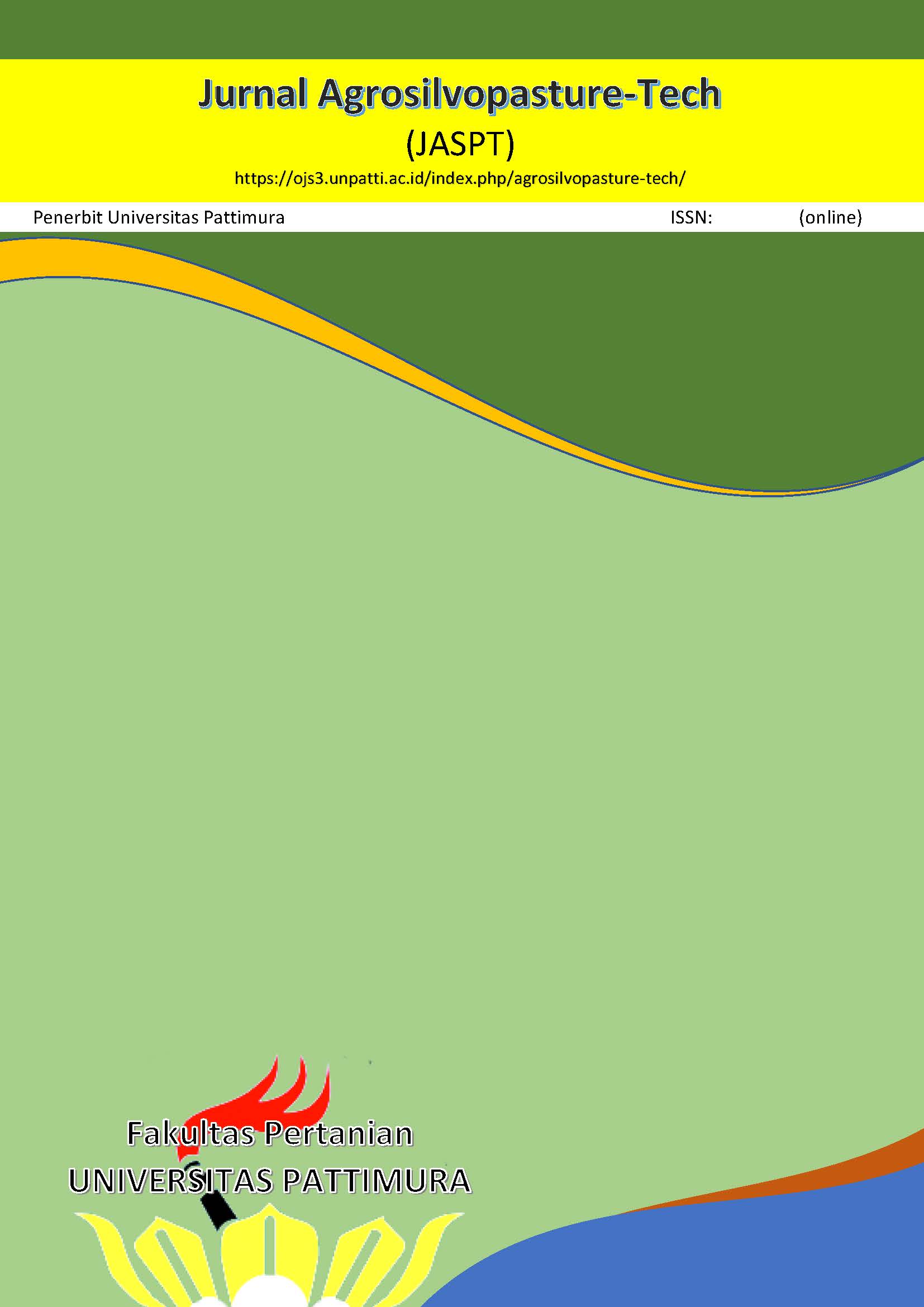Chemical Properties of Sago Grub (Rhynchophorus ferrugineus) Protein Concentrate With Different Initial Drying Method
Abstract
The sago grub (Rhychophorus ferrugineus) is a kind of edible insect which can be utilized as an substitute source of protein in the form of concentrates. The extraction process of protein concentrate requires a proper drying technique for the starting material. This study was intended to determine the appropriate initial drying method for sago grub to produce protein concentrates with good chemical properties. In this study, cabinet dryer, sun, and oven drying methods were used to extract sago caterpillar protein concentrate with a block randomized design. The variables observed were the moisture, ash, protein, and fat contents of the sago grub protein concentrate. The results demonstrated that cabinet dryers are the most appropriate drying method for producing protein concentrate with the best chemical and functional characteristics. The drying method of the cabinet dryer produces a protein concentrate with a moisture content of 23%, an ash content of 11.26%, a protein content of 55.37%, and a fat content of 7.67%.
Downloads
References
Abdel-Moniem, A. S. H., El-Kholy, M. Y., & Elshekh, W. E. A. (2017). The red palm weevil, Rhynchophorus ferrugineus Olivier, as edible insects for food and feed: A Case Study in Egypt. Research Journal of Pharmaceutical, Biological and Chemical Sciences, 8(3), 1653–1658.
AOAC. (2019). Official Methods Of Analysis Book (21st Edition). Association of Official Anaylitical Chemist. Inc. https://www.aoac.org/official-methods-of-analysis-21st-edition-2019/
Asgar, A., Musaddad, D., Rahayu, S. T., & Levianny, P. S. (2022). Effect of temperature and drying time on chemical, physical, and organoleptic characteristics of dry winged beans. IOP Conference Series: Earth and Environmental Science, 1024:01200.
Day, L., Cakebread, J. A., & Loveday, S. M. (2022). Food proteins from animals and plants: Differences in the nutritional and functional properties. Trends in Food Science & Technology, 119, 428–442. https://doi.org/https://doi.org/10.1016/j.tifs.2021.12.020
Hewavitharana, G. G., Perera, D. N., Navaratne, S. B., & Wickramasinghe, I. (2020). Extraction methods of fat from food samples and preparation of fatty acid methyl esters for gas chromatography: A review. Arabian Journal of Chemistry, 13(8), 6865–6875.
Kariyanto, R. A. (2014). Pengaruh Pengeringan Sinar Matahari dan Oven Terhadap Emulsifikasi, Daya Buih, dan Daya Serap Minyak Pada Konsentrat Protein Hati Sapi [Universitas Brawijaya]. http://repository.ub.ac.id/id/eprint/137224/
Köhler, R., Irias-Mata, A., Ramandey, E., Purwestri, R., & Biesalski, H. K. (2020). Nutrient composition of the Indonesian sago grub (Rhynchophorus bilineatus). International Journal of Tropical Insect Science, 40(3), 677–686. https://doi.org/10.1007/s42690-020-00120-z
Maruatona, G. N., Duodu, K. G., & Minnaar, A. (2010). Physicochemical, nutritional and functional properties of marama bean flour. Food Chemistry, 121(2), 400–405. https://doi.org/https://doi.org/10.1016/j.foodchem.2009.12.054
Melgar-Lalanne, G., Hernández-Álvarez, A.-J., & Salinas-Castro, A. (2019). Edible insects processing: traditional and innovative technologies. Comprehensive Reviews in Food Science and Food Safety, 18(4), 1166–1191. https://doi.org/10.1111/1541-4337.12463
Mune, M. A. M., & Sogi, D. S. (2015). Emulsifying and foaming properties of protein concentrates prepared from cowpea and bambara bean using different drying methods. International Journal of Food Properties, 19(2), 371–384. https://doi.org/10.1080/10942912.2015.1023399
Ndiritu, A. K., Kinyuru, J. N., Kenji, G. M., & Gichuhi, P. N. (2017). Extraction technique influences the physico-chemical characteristics and functional properties of edible crickets (Acheta domesticus) protein concentrate. Journal of Food Measurement and Characterization, 11(4), 2013–2021. https://doi.org/10.1007/s11694-017-9584-4
Oo, Z. Z., Ko, T. L., & Than, S. S. (2017). Physico-chemical properties of extracted mung bean protein concentrate. American Journal of Food Science and Technology, 5(6), 265–269. https://doi.org/10.12691/ajfst-5-6-7
Patel, S., Suleria, H. A. R., & Rauf, A. (2019). Edible insects as innovative foods: Nutritional and functional assessments. Trends in Food Science & Technology, 86, 352–359. https://doi.org/https://doi.org/10.1016/j.tifs.2019.02.033
Rieuwpassa, F. J., & Cahyono, E. (2019). Karakteristik fisiko-kimia konsentrat protein ikan sunglir (Elagatis bipinulatus). Jurnal MIPA UNSRAT, 8(3), 164–167. https://doi.org/https://doi.org/10.35799/jmuo.8.3.2019.26189
Tafiany, R. A. (2021). Pengaruh Metode Pengeringan Terhadap Sifat Fungsional Konsentrat Protein Kepala Ayam [Universitas Brawijaya]. http://repository.ub.ac.id/id/eprint/188071/
van Huis, A. (2013). Potential of insects as food and feed in assuring food security. Annual Review of Entomology, 58(1), 563–583. https://doi.org/10.1146/annurev-ento-120811-153704
van Huis, A. (2015). Edible insects contributing to food security? Agriculture & Food Security, 4(1), 20. https://doi.org/10.1186/s40066-015-0041-5
van Huis, A., & Oonincx, D. G. A. B. (2017). The environmental sustainability of insects as food and feed. A review. Agronomy for Sustainable Development, 37(5), 43. https://doi.org/10.1007/s13593-017-0452-8
Womeni, H. M., Tiencheu, B., Linder, M., Nabayo, E. M. C., Tenyang, N., Mbiapo, F. T., Villeneuve, P., Fanni, J., & Parmentier, M. (2012). Nutritional value and effect of cooking, drying, and storage process on some functional properties of Rhynchophorus phoenicis. Journal of Life Science and Pharma Research, 2(203-219).
Yunianto, W. T. (2014). Pegaruh Pengeringan Dengan Sinar Matahari dan Oven Terhadap Emulsifikasi, Daya Serap Minyak, dan Daya Buih Pada Konsentrat Protein Paru Sapi [Universitas Brawijaya]. http://repository.ub.ac.id/id/eprint/137226/
Zielińska, E., Karaś, M., & Baraniak, B. (2018). Comparison of functional properties of edible insects and protein preparations thereof. LWT, 91, 168–174. https://doi.org/https://doi.org/10.1016/j.lwt.2018.01.058
Copyright (c) 2023 The Author(s)

This work is licensed under a Creative Commons Attribution-ShareAlike 4.0 International License.




.png)

